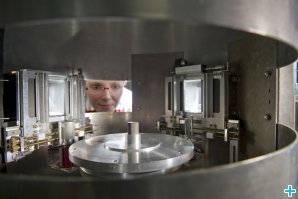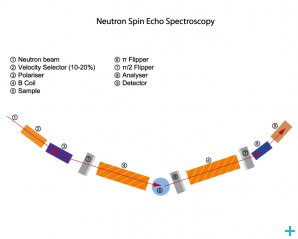Spin echo spectroscopy
The technique and the facilities where you can find it
Overview
Spin Echo Spectroscopy (NSE) uses the velocity change of the neutrons to infer the energy transfer – to achieve a higher resolution than with conventional time-of-flight-methods, the neutron spin directions are used as a kind of individual stop watches.
Conventional neutron spectroscopic methods (3-axis, TOF, back-scattering) define the incident energy Ei and final neutron energy Ef separately. Both energy selections have to be done with the desired resolution of the instrument. Therefore, the detected neutron flux decreases as the square of the resolution. This makes it impossible to reach resolutions below about 1 µeV without prohibitive loss of counting statistics.
One basic idea of the NSE spectrometer is that only the energy transfer – the difference Ef-Ei – has to be known. So a large range of incident neutron energies (e.g. 20% spread) can be used provided that the neutrons carry individual information of their energy. This is achieved by the second idea of NSE to use the neutron spin's Larmor precession as an internal clock.
The principle of spin echo
In practice, the neutrons are guided through identical magnetic fields before and after the scattering. A π flipper close to the sample position inverts the spin orientation so that the second rotation exactly compensates the first if the speed of the neutrons is not changed by the scattering (elastic).
In addition, π/2 flippers are used to convert longitudinal into transverse polarisation and vice versa.
The spin orientation, or polarisation, is restored at the end of the instrument and that is what is called the spin echo.
If the scattering is inelastic, the neutrons stay either longer or shorter in the second field after scattering. Then, the rotations do not match and the polarisation is (partially) lost. From the decay of polarisation it is possible to deduce the inelastic scattering in terms of the intermediate scattering function S(Q,t).
High energy resolution is needed when studying slow dynamics at timescales of about 0.1-100 ns on a nanometer length scale.
In soft matter systems, this corresponds to thermally activated processes like the motion of polymer chains in the melt or in solution, domain motions of proteins or fluctuations of surfactant membranes in microemulsions.
In hard matter systems, the dynamics of spin glasses is a possible application of NSE.
Larmor precession
The neutron possese a spin of 1/2 and thus a magnetic moment (P). When put into a magnetic field (B) the spin will start a precession movement around the magnetic field direction called the Larmor precession.
This rotation has a fixed frequency which depends only on the magnetic field applied. It is therefore possible by applying magnetic fields of definite strength and duration to perform controlled manipulations of the neutron beam polarisation.


